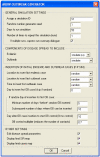Using GIS to create synthetic disease outbreaks
- PMID: 17300714
- PMCID: PMC1805744
- DOI: 10.1186/1472-6947-7-4
Using GIS to create synthetic disease outbreaks
Abstract
Background: The ability to detect disease outbreaks in their early stages is a key component of efficient disease control and prevention. With the increased availability of electronic health-care data and spatio-temporal analysis techniques, there is great potential to develop algorithms to enable more effective disease surveillance. However, to ensure that the algorithms are effective they need to be evaluated. The objective of this research was to develop a transparent user-friendly method to simulate spatial-temporal disease outbreak data for outbreak detection algorithm evaluation. A state-transition model which simulates disease outbreaks in daily time steps using specified disease-specific parameters was developed to model the spread of infectious diseases transmitted by person-to-person contact. The software was developed using the MapBasic programming language for the MapInfo Professional geographic information system environment.
Results: The simulation model developed is a generalised and flexible model which utilises the underlying distribution of the population and incorporates patterns of disease spread that can be customised to represent a range of infectious diseases and geographic locations. This model provides a means to explore the ability of outbreak detection algorithms to detect a variety of events across a large number of stochastic replications where the influence of uncertainty can be controlled. The software also allows historical data which is free from known outbreaks to be combined with simulated outbreak data to produce files for algorithm performance assessment.
Conclusion: This simulation model provides a flexible method to generate data which may be useful for the evaluation and comparison of outbreak detection algorithm performance.
Figures







Similar articles
-
Application of an automated surveillance-data-analysis system in a laboratory-based early-warning system for detection of an abortion outbreak in mares.Am J Vet Res. 2009 Feb;70(2):247-56. doi: 10.2460/ajvr.70.2.247. Am J Vet Res. 2009. PMID: 19231958
-
A simulation study comparing aberration detection algorithms for syndromic surveillance.BMC Med Inform Decis Mak. 2007 Mar 1;7:6. doi: 10.1186/1472-6947-7-6. BMC Med Inform Decis Mak. 2007. PMID: 17331250 Free PMC article.
-
[Analysis on the multi-distribution and the major influencing factors on severe acute respiratory syndrome in Beijing].Zhonghua Liu Xing Bing Xue Za Zhi. 2005 Mar;26(3):164-8. Zhonghua Liu Xing Bing Xue Za Zhi. 2005. PMID: 15941497 Chinese.
-
The spatial epidemiologic (r)evolution: a look back in time and forward to the future.Spat Spatiotemporal Epidemiol. 2011 Sep;2(3):119-24. doi: 10.1016/j.sste.2011.07.002. Epub 2011 Jul 21. Spat Spatiotemporal Epidemiol. 2011. PMID: 22748171 Review.
-
Spatio-temporal epidemiology: principles and opportunities.Spat Spatiotemporal Epidemiol. 2011 Mar;2(1):1-9. doi: 10.1016/j.sste.2010.10.001. Epub 2010 Nov 24. Spat Spatiotemporal Epidemiol. 2011. PMID: 22749546 Review.
Cited by
-
Building an Interactive Geospatial Visualization Application for National Health Care-Associated Infection Surveillance: Development Study.JMIR Public Health Surveill. 2021 Jul 30;7(7):e23528. doi: 10.2196/23528. JMIR Public Health Surveill. 2021. PMID: 34328436 Free PMC article.
-
Disease surveillance using a hidden Markov model.BMC Med Inform Decis Mak. 2009 Aug 10;9:39. doi: 10.1186/1472-6947-9-39. BMC Med Inform Decis Mak. 2009. PMID: 19664256 Free PMC article.
-
Rank-based spatial clustering: an algorithm for rapid outbreak detection.J Am Med Inform Assoc. 2011 May 1;18(3):218-24. doi: 10.1136/amiajnl-2011-000137. J Am Med Inform Assoc. 2011. PMID: 21486881 Free PMC article.
-
Validity of evaluation approaches for outbreak detection methods in syndromic surveillance systems.Iran J Public Health. 2012;41(11):102-3. Epub 2012 Nov 1. Iran J Public Health. 2012. PMID: 23304684 Free PMC article. No abstract available.
-
Template-driven spatial-temporal outbreak simulation for outbreak detection evaluation.AMIA Annu Symp Proc. 2008 Nov 6;2008:854-8. AMIA Annu Symp Proc. 2008. PMID: 18999301 Free PMC article.
References
-
- Lawson AB, Klieinman K. Introduction: Spatial and syndromic surveillance for public health. In: Lawson AB and Klienman K, editor. Spatial and syndromic surveillance for public health. Chichester, Wiley; 2005. pp. 1–10.
-
- Buehler JW, Hopkins RS, Overhage JM, Sosin DM, Tong V, CDC working Group Framework for evaluating public health surveillance systems for early detection of outbreaks: Recommendations from the CDC Working Group. MMWR Recomm Rep. 2004;53:1–11. - PubMed
-
- Bonetti M, Pagano M. The interpoint distance distribution as a descriptor of point patterns, with an application to spatial disease clustering. Stat Med. 2005;24:753–773. - PubMed
-
- Kulldorff M, Zhang Z, Hartman J, Heffernan R, Huang L, Mostashari F. Evaluating disease outbreak detection methods: Benchmark data and power calculations. MMWR Morb Mortal Wkly Rep. 2004;53:144–151. - PubMed
Publication types
MeSH terms
LinkOut - more resources
Full Text Sources
Other Literature Sources

